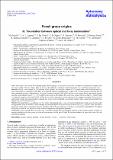Files in this item
Fossil group origins III. The relation between optical and X-ray luminosities
Item metadata
| dc.contributor.author | Girardi, M. | |
| dc.contributor.author | Aguerri, J. A. L. | |
| dc.contributor.author | De Grandi, S. | |
| dc.contributor.author | D'Onghia, E. | |
| dc.contributor.author | Barrena, R. | |
| dc.contributor.author | Boschin, W. | |
| dc.contributor.author | Mendez Abreu, Jairo | |
| dc.contributor.author | Sanchez-Janssen, R. | |
| dc.contributor.author | Zarattini, S. | |
| dc.contributor.author | Biviano, A. | |
| dc.contributor.author | Castro-Rodriguez, N. | |
| dc.contributor.author | Corsini, E. M. | |
| dc.contributor.author | del Burgo, C. | |
| dc.contributor.author | Iglesias-Paramo, J. | |
| dc.contributor.author | Vilchez, J. M. | |
| dc.date.accessioned | 2014-08-28T09:01:01Z | |
| dc.date.available | 2014-08-28T09:01:01Z | |
| dc.date.issued | 2014-05-21 | |
| dc.identifier | 134760076 | |
| dc.identifier | 50aca6fe-96e3-4bb0-8c28-95f8ff772f3a | |
| dc.identifier | 000336730900115 | |
| dc.identifier | 84901258903 | |
| dc.identifier | 000336730900115 | |
| dc.identifier.citation | Girardi , M , Aguerri , J A L , De Grandi , S , D'Onghia , E , Barrena , R , Boschin , W , Mendez Abreu , J , Sanchez-Janssen , R , Zarattini , S , Biviano , A , Castro-Rodriguez , N , Corsini , E M , del Burgo , C , Iglesias-Paramo , J & Vilchez , J M 2014 , ' Fossil group origins III. The relation between optical and X-ray luminosities ' , Astronomy & Astrophysics , vol. 565 , 115 . https://doi.org/10.1051/0004-6361/201323311 | en |
| dc.identifier.issn | 0004-6361 | |
| dc.identifier.uri | https://hdl.handle.net/10023/5268 | |
| dc.description | M.G. acknowledges financial support from the PRIN-INAF/2010 and MIUR PRIN/2010-2011 (J91J12000450001). E.D. gratefully acknowledges the support of the Alfred P. Sloan Foundation. J.M.A. acknowledges support from the European Research Council Starting Grant (SEDmorph; P.I. V. Wild). EMC is supported by Padua University (grants 60A02-1283/10, 5052/11, 4807/12). J.I.P. and J.V.M. acknowledge financial support from the Spanish MINECO under grant AYA2010-21887-C04-01, and from Junta de Andalucía Excellence Project PEX2011-FQM7058. This work has been supported by the Programa Nacional de Astronomía y Astrofísica of the Spanish Ministry of Science and Innovation under grants AYA2010-21887-C04-04, AYA2007-67965-C03-01 and under the Consolider-Ingenio 2010 Program grant CSD2006-00070: First Science with the GTC (http://www.iac.es/consolider-ingenio-gtc). This work was partially funded by the local Canarian Government (grant ProID20100140). | en |
| dc.description.abstract | Aims. This study is part of the Fossil group origins (FOGO) project which aims to carry out a systematic and multiwavelength study of a large sample of fossil systems. Here we focus on the relation between the optical luminosity (Lopt) and X-ray luminosity (LX). Methods. Out of a total sample of 28 candidate fossil systems, we consider a sample of 12 systems whose fossil classification has been confirmed by a companion study. They are compared with the complementary sample of 16 systems whose fossil nature has not been confirmed and with a subsample of 102 galaxy systems from the RASS-SDSS galaxy cluster survey. Fossil and normal systems span the same redshift range 0 <z< 0.5 and have the same LX distribution. For each fossil system, the LX in the 0.1-2.4keV band is computed using data from the ROSAT All Sky Survey to be comparable to the estimates of the comparison sample. For each fossil and normal system we homogeneously compute Lopt in the r-band within the characteristic cluster radius, using data from the Sloan Digital Sky Survey Data Release 7. Results. We sample the LX-Lopt relation over two orders of magnitude in LX. Our analysis shows that fossil systems are not statistically distinguishable from the normal systems through the 2D Kolmogorov-Smirnov test nor the fit of the LX-Lopt relation. Thus, the optical luminosity of the galaxy system does strongly correlate with the X-ray luminosity of the hot gas component, independently of whether the system is fossil or not. We discuss our results in comparison with previous literature. Conclusions. We conclude that our results are consistent with the classical merging scenario of the brightest galaxy formed via merger/cannibalism of other group galaxies with conservation of the optical light. We find no evidence for a peculiar state of the hot intracluster medium. | |
| dc.format.extent | 12 | |
| dc.format.extent | 401038 | |
| dc.language.iso | eng | |
| dc.relation.ispartof | Astronomy & Astrophysics | en |
| dc.subject | Galaxies: clusters: general | en |
| dc.subject | X-rays: galaxies: clusters | en |
| dc.subject | Cosmology: observations | en |
| dc.subject | Digital sky survey | en |
| dc.subject | Galaxy cluster survey | en |
| dc.subject | Scale-independent method | en |
| dc.subject | To-light ratios | en |
| dc.subject | Rich clusters | en |
| dc.subject | Data release | en |
| dc.subject | Velocity dispersion | en |
| dc.subject | Catalog | en |
| dc.subject | Mass | en |
| dc.subject | SDSS | en |
| dc.subject | QB Astronomy | en |
| dc.subject.lcc | QB | en |
| dc.title | Fossil group origins III. The relation between optical and X-ray luminosities | en |
| dc.type | Journal article | en |
| dc.contributor.sponsor | European Research Council | en |
| dc.contributor.institution | University of St Andrews. School of Physics and Astronomy | en |
| dc.identifier.doi | 10.1051/0004-6361/201323311 | |
| dc.description.status | Peer reviewed | en |
| dc.identifier.grantnumber | ERC-2012-StG-20111012 | en |
This item appears in the following Collection(s)
Items in the St Andrews Research Repository are protected by copyright, with all rights reserved, unless otherwise indicated.

